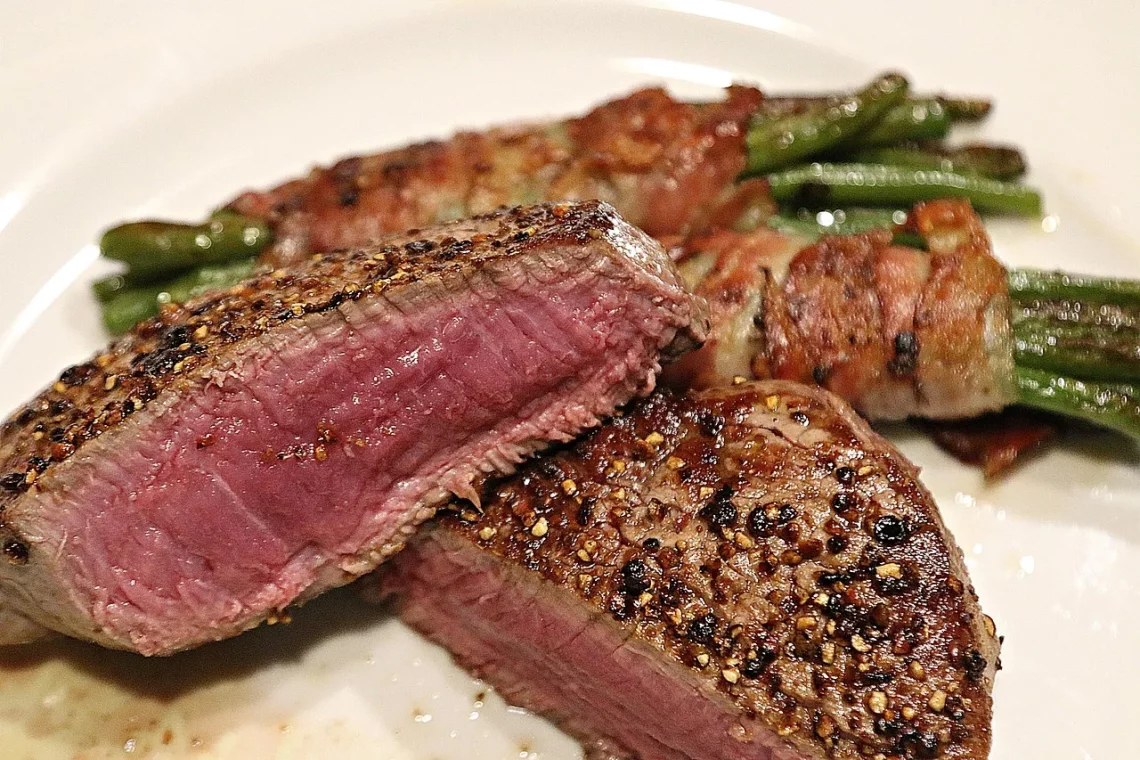
T Bone Steak Nutrition Facts and Health Benefits Explained
T-bone steak is a culinary delight that stands out not only for its rich flavor but also for its nutritional profile. This cut of meat, characterized by its distinctive T-shaped bone, is a favorite among meat lovers and is often associated with grilling and barbecues. Originating from the short loin section of the cow, the T-bone steak offers a combination of two different types of meat: the tenderloin and the strip steak. This unique composition not only contributes to its taste but also makes it a source of various essential nutrients.
As people become increasingly health-conscious, understanding the nutritional facts and health benefits of foods like T-bone steak is crucial. Many individuals are looking for ways to enjoy their favorite dishes while maintaining a balanced diet. The good news is that T-bone steak can be part of a healthy eating plan when consumed in moderation. It provides high-quality protein, essential vitamins, and minerals that contribute to overall health. Furthermore, incorporating lean cuts of meat into your meals can help you meet your dietary needs without compromising on flavor.
In this article, we will delve into the nutritional facts of T-bone steak and explore its health benefits, shedding light on why this cut of meat deserves a place on your dinner plate.
Understanding the Nutritional Profile of T-Bone Steak
T-bone steak is not only delicious but also packed with nutrients that can play a vital role in your diet. A typical serving of T-bone steak, which is about 3.5 ounces (100 grams), contains a variety of macronutrients and micronutrients that are essential for health.
First and foremost, T-bone steak is an excellent source of protein. Protein is crucial for building and repairing tissues, making enzymes and hormones, and supporting overall bodily functions. A serving can provide approximately 25 grams of protein, making it a perfect choice for those looking to increase their protein intake, whether for muscle building or general health.
In addition to protein, T-bone steak contains significant amounts of important vitamins and minerals. For instance, it is rich in B vitamins, particularly B12, which is essential for red blood cell formation and neurological function. A serving of T-bone steak can provide a substantial percentage of the daily recommended intake of B12, making it a great option for those looking to boost their levels of this vital nutrient.
Iron is another key mineral found in T-bone steak. Iron is crucial for transporting oxygen in the blood and is especially important for individuals who may be at risk of iron deficiency, such as pregnant women or those with certain dietary restrictions. The heme iron found in red meat is more easily absorbed by the body compared to non-heme iron found in plant sources, making T-bone steak an excellent source for meeting iron needs.
Moreover, T-bone steak contains zinc, which supports immune function, wound healing, and DNA synthesis. A serving can contribute significantly to your daily zinc requirements, making it a valuable food for maintaining overall health.
While T-bone steak does contain fat, it is important to note that not all fats are created equal. This cut of meat provides a mix of saturated and unsaturated fats. The unsaturated fats can be beneficial when consumed in moderation, as they help to support heart health and maintain healthy cholesterol levels.
In summary, T-bone steak is a nutrient-dense food that offers a wide range of health benefits when consumed as part of a balanced diet. Its high protein content, abundance of vitamins and minerals, and flavorful profile make it a popular choice among meat lovers.
Health Benefits of T-Bone Steak
Incorporating T-bone steak into your diet can provide several health benefits, thanks to its rich nutrient profile. Understanding these benefits can help you make an informed decision about including this cut of meat in your meals.
One of the primary health benefits of T-bone steak is its role in promoting muscle growth and repair. With its high protein content, it provides the necessary amino acids that the body requires for muscle synthesis. This is particularly beneficial for athletes and those engaged in regular physical activity, as protein consumption post-workout can enhance recovery and muscle development.
Additionally, the presence of essential vitamins and minerals in T-bone steak supports various bodily functions. For example, the B vitamins found in this cut contribute to energy metabolism, helping the body convert the food we eat into usable energy. This can be particularly advantageous for individuals leading active lifestyles or those needing an energy boost throughout the day.
Moreover, the iron content in T-bone steak plays a crucial role in maintaining optimal energy levels. Iron is essential for preventing fatigue and ensuring that the body’s cells receive adequate oxygen. This is especially important for individuals who may experience low energy levels due to insufficient iron intake, such as athletes or those on restrictive diets.
T-bone steak is also beneficial for bone health due to its zinc content. Zinc is vital for maintaining bone density and strength, and its presence in T-bone steak can contribute to overall skeletal health. Additionally, the protein in T-bone steak aids in maintaining muscle mass, which is important for sustaining bone strength as we age.
Another notable benefit of T-bone steak is its satiating effect. The combination of protein and fat in this cut can help you feel fuller for longer periods, potentially reducing the likelihood of overeating or snacking on less nutritious foods. This can be particularly helpful for those looking to manage their weight or maintain a healthy lifestyle.
While T-bone steak can offer numerous health benefits, it is essential to enjoy it in moderation and balance it with a variety of other foods, including fruits, vegetables, and whole grains, to ensure a well-rounded diet.
Choosing and Preparing T-Bone Steak
When it comes to enjoying T-bone steak, the quality of the meat and the method of preparation can greatly influence both taste and health benefits. Selecting the right cut and cooking it properly can enhance your overall dining experience.
When choosing T-bone steak, look for cuts that have a bright red color and good marbling. Marbling refers to the small flecks of fat within the muscle, which can enhance flavor and tenderness. Opt for grass-fed or organic options when possible, as these tend to have a better nutrient profile and are often raised in more humane conditions.
Preparation methods can also impact the healthfulness of your meal. Grilling, broiling, or baking T-bone steak are preferable options as they allow excess fat to drip away during cooking. Avoid frying or cooking with excessive oils and butter, which can add unnecessary calories and unhealthy fats.
Before cooking, consider marinating the steak to enhance its flavor and tenderness. A simple marinade of olive oil, garlic, and herbs can complement the natural flavors of the meat while also adding beneficial nutrients. Additionally, allowing the steak to come to room temperature before cooking can ensure a more even cook.
When cooking T-bone steak, use a meat thermometer to ensure it reaches a safe internal temperature. For medium-rare, aim for around 135°F (57°C), while medium should reach about 145°F (63°C). Letting the steak rest for a few minutes after cooking allows the juices to redistribute, resulting in a more flavorful and juicy meal.
Serving T-bone steak alongside a variety of sides can enhance the nutritional value of the meal. Consider pairing it with roasted vegetables, a fresh salad, or whole grains like quinoa or brown rice. This way, you can create a balanced plate that includes a range of nutrients.
In summary, choosing high-quality T-bone steak and preparing it thoughtfully can lead to a delicious and nutritious meal. By incorporating this cut of meat into your diet mindfully, you can enjoy its rich flavors while reaping its health benefits.
Moderation and Balance: The Key to Enjoying T-Bone Steak
While T-bone steak offers numerous nutritional benefits, moderation is crucial for maintaining a healthy diet. It is essential to recognize that, as with any food, balance is key to ensuring overall health and well-being.
Incorporating T-bone steak into your meals can provide valuable nutrients, but it should not be the sole focus of your diet. Aim to enjoy red meat in moderation, perhaps reserving it for special occasions or as part of a weekly meal plan. This allows you to appreciate its flavor while also making room for a diverse array of other foods.
Consider alternating T-bone steak with other protein sources, such as poultry, fish, legumes, and plant-based proteins. This variety can help you obtain a broader range of nutrients and prevent the potential negative effects of consuming too much red meat. Research has shown that a diverse diet can support better health outcomes and reduce the risk of chronic diseases.
Additionally, pay attention to portion sizes. A standard serving of T-bone steak is about 3.5 ounces (100 grams), which is sufficient to enjoy its flavors while meeting your protein needs. Larger portions can lead to excess calorie intake and may contribute to health issues if consumed regularly.
Furthermore, be mindful of the cooking methods you choose. Opting for healthier preparation techniques, such as grilling or baking, can help reduce the added fats and calories that often come with frying. Pairing your T-bone steak with plenty of vegetables and whole grains can enhance the meal’s nutritional value and provide additional fiber.
In conclusion, while T-bone steak can be a delicious and nutritious part of your diet, it is essential to enjoy it in moderation and as part of a balanced eating plan. By doing so, you can savor its rich flavors while reaping its health benefits without compromising your overall well-being.
**Disclaimer:** This article is for informational purposes only and should not be considered medical advice. For health-related issues or concerns, please consult a healthcare professional.




